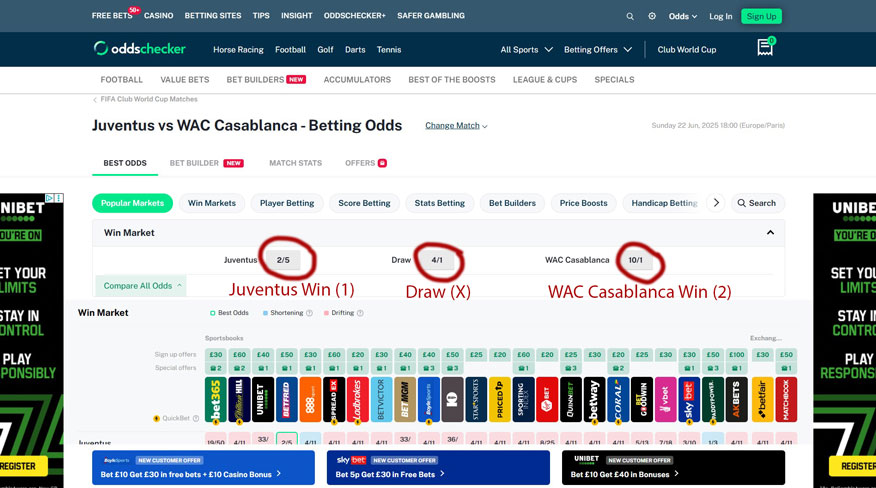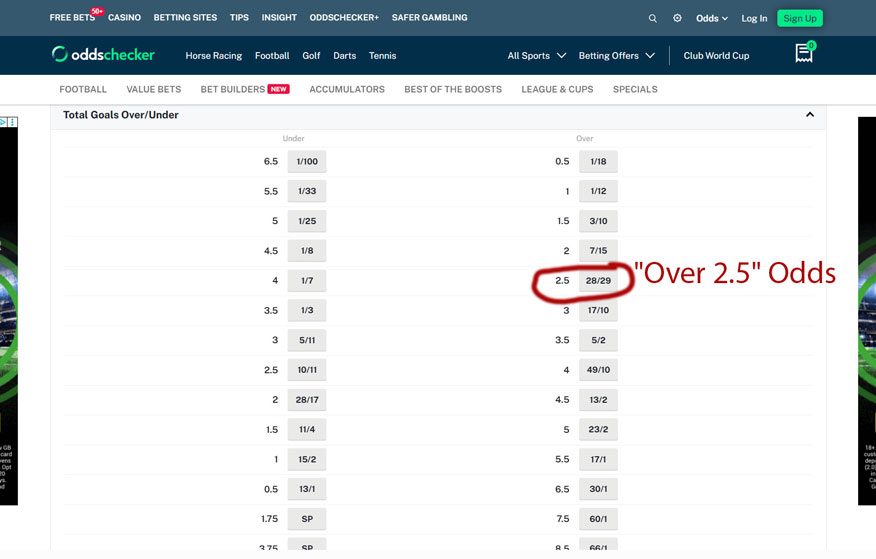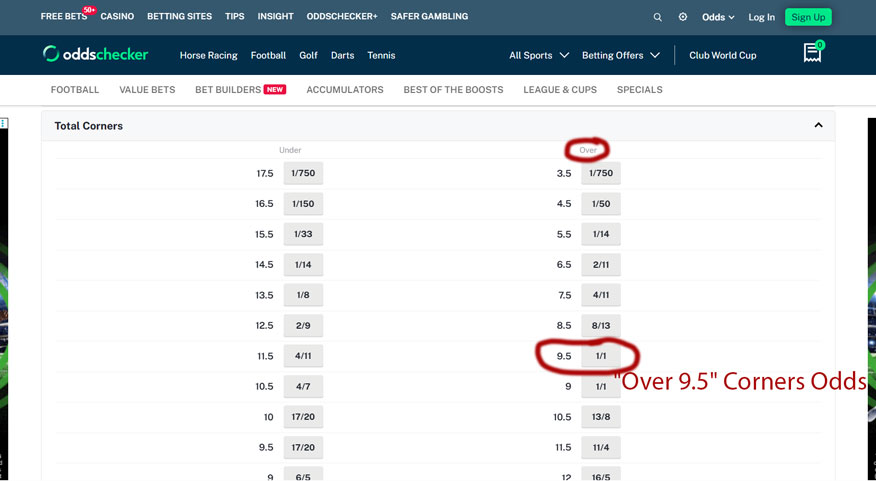
Introduction: Why 95% of Bettors Lose Money (And How You Can Join the 5%)
If you’re reading this, you’ve probably placed a bet on a heavy favourite to win a football match. It seems logical, but it’s the single biggest reason why most punters consistently lose money. They bet on who they think will win, not on whether the odds offer good value.
Welcome to the ultimate guide that will fundamentally change your approach. We will teach you the single most important skill in sports betting: how to find value bets.
This is more than just a betting theory; it’s a proven sports betting value strategy that separates casual gamblers from sharp investors. By the end of this guide, you’ll understand the core concepts, learn the exact formula to use, and know the step-by-step process for finding profitable odds in football. This is value betting for beginners, made simple.
Value Betting Explained: Thinking Like an Investor, Not a Fan
So, what is value betting? Let’s use a simple analogy.
Imagine a new PlayStation 5 costs £480. That’s its true market price. One day, you find a brand-new, boxed PS5 on sale for £400. You’d buy it instantly, knowing you’re getting a great deal. That’s value.
Now, imagine the same shop tries to sell you that PS5 for £600. You’d never buy it. That’s bad value.
Value betting is the exact same principle. You are looking for odds that are “on sale”—a price that is better than the true probability of the outcome.
A value bet is not a bet that is guaranteed to win. It is a bet where the bookmaker’s odds are higher than they should be.
Understanding Implied Probability
Every set of odds has an “implied probability” – the chance the bookmaker believes an outcome has of happening. You can calculate it with a simple formula:
Implied Probability % = (1 / Decimal Odds) * 100
- Odds of 2.00 imply a 50% chance (1 / 2.00 * 100).
- Odds of 3.00 imply a 33.3% chance (1 / 3.00 * 100).
- Odds of 1.50 imply a 66.7% chance (1 / 1.50 * 100).
You find a value bet when your own analysis tells you the true probability is higher than what the odds imply.
Beating the Bookie: Understanding the Margin (Overround)
How do bookmakers make money? By building a profit margin, known as the overround, into their odds. If you calculate the implied probability for all outcomes of a match (Win, Draw, Loss), the total will always be more than 100%. This extra percentage is their guaranteed profit.
Let’s use the odds from our screenshot for the Juventus vs WAC Casablanca match to see this in action. The image shows the best available fractional odds, which we’ll first convert to decimal.

1. Convert fractional odds to decimal:
Juventus Win (2/5) = 1.40
Draw (4/1) = 5.00
WAC Casablanca Win (10/1) = 11.00
2. Calculate implied probability for each outcome:
Juventus: (1 / 1.40) * 100 = 71.43%
Draw: (1 / 5.00) * 100 = 20.00%
WAC Casablanca: (1 / 11.00) * 100 = 9.09%
3. Sum the probabilities to find the margin:
Total = 71.43% + 20.00% + 9.09% = 100.52%
Bookmaker’s Margin = 0.52%
That extra 0.52% is the bookmaker’s margin. This is a very low margin, which indicates good odds for the punter, but it’s crucial to understand that it still exists. It’s this built-in advantage that makes consistently finding value the only way to be profitable long-term.
The Value Betting Formula: Your Key to Profitability
This simple formula is all you need to mathematically identify a value bet.
(Odds * Your Assessed Probability %) / 100 > 1
If the result is greater than 1, you have found value. If it’s less than 1, it’s a bad value bet.
How to Find Value Bets: A Step-by-Step Guide
This is the practical guide for how to calculate betting value and find opportunities.
Step 1: Choose a Match. Let’s use our Juventus vs. WAC Casablanca match as the case study. We are interested in the “Total Goals” market.
Step 2: Do Your Own Analysis. This is the art. Ignore the odds for a moment. Analyse the fixture. Juventus is a heavy favourite, likely to dominate and score multiple goals. WAC Casablanca will defend, but might concede under pressure. You predict an open, high-scoring game.
Step 3: Assign Your Own Probability. Based on your analysis of the teams’ attacking styles, you assess the true probability of the match having “Total Goals Over 2.5” to be 60%.
Step 4: Hunt for the Best Odds. You now shop around and find the best price for “Over 2.5 Goals”. As our screenshot shows, the best odds you can find are 28/29, which is 1.97 in decimal odds.

Step 5: The Calculation. Now we apply the value betting formula using the real odds from our screenshot:
The best available odds = 1.97 (which is 28/29 in fractional odds).
Our Assessed Probability = 60%.
Let’s do the calculation:
(1.97 * 60) / 100 = 1.182
The result is 1.182, which is greater than 1. This is a perfect example of a value bet. Our analysis suggests the true probability (60%) is higher than the one implied by the odds (1 / 1.97 = 50.7%). This difference, or “edge,” is what creates long-term profit.
Value Betting in Action: More Football Examples
Finding value odds in football isn’t limited to one market. A sharp punter assesses multiple angles for every match. Here are three different real-world examples showing how to apply the value betting strategy.
Football Example 1: The “Total Goals” Market
This is the main example we used in our step-by-step guide. Let’s recap it.
The Match: Juventus vs. WAC Casablanca.
The Analysis: We assess that there is a 60% true probability of the match having “Over 2.5 Goals”.
The Odds: We find the best available odds are 28/29 (which is 1.97 in decimal).
The Calculation: (1.97 * 60) / 100 = 1.182.
The Verdict: The result is greater than 1, so this is a value bet.
Football Example 2: The “Match Winner” (1X2) Market
Here we look for an upset where the underdog’s chances are underestimated.
The Match: An in-form Crystal Palace (at home) vs. a top-four Liverpool side who played a tough Champions League match mid-week.
The Analysis: The bookies heavily favour Liverpool. But our analysis shows Palace are strong at home, and Liverpool’s key players might be fatigued. We assess Crystal Palace’s true chance of winning at 25%.
The Odds: The bookmaker offers high odds of 5.00 for a Palace win (which implies only a 20% probability).
The Calculation: (5.00 * 25) / 100 = 1.25.
The Verdict: The result is significantly greater than 1. This is a classic example of a high-odds, high-value bet.
Football Example 3: Statistical Markets (Corners)
Value isn’t just found in match winners or goals. It’s often hiding in statistical markets like corners. Let’s use our Juventus vs. WAC Casablanca example again.
The Analysis: Juventus is the heavy favourite and is expected to dominate possession and attack for most of the game. Top teams playing against a deep-defending side often generate a high number of corners because many shots and crosses get blocked. Juventus’s attacking style, which heavily involves wing-play, supports this theory. After analysing their recent matches, we assess the true probability of “Over 9.5” corners as 55%.

The Odds: We look at our screenshot and see the best odds for “Over 9.5” corners are 1/1, which is 2.00 in decimal odds.
The Calculation: (2.00 * 55) / 100 = 1.10.
The Verdict: The result is 1.10 (> 1), meaning we’ve identified another solid value bet. We used tactical analysis to find an edge that the market might have overlooked.
An Advanced Concept: Understanding Closing Line Value (CLV)
A key sign that you are successfully finding value is consistently achieving “Closing Line Value” (CLV). This means the odds you took have shortened by the time the match starts. If you bet on Crystal Palace at 5.00 and by kick-off the odds have dropped to 4.50, it means the market agreed with your assessment. Beating the closing line is a strong indicator of long-term profitability.
Common Value Betting Mistakes to Avoid
Chasing “Steamers”: Betting on odds that are already shortening. The value is likely already gone.
Confirmation Bias: Only looking for stats that support the bet you want to make.
Poor Bankroll Management: Placing too much of your bankroll on one value bet. Even good value bets can lose.
Value Betting FAQ: Your Questions Answered
Is value betting a guaranteed way to win? No. It is a strategy that guarantees you a statistical edge over the bookmaker, which leads to profit over the long term. You will have many losing bets.
Is value betting profitable? Yes. It is the only mathematically proven method for achieving long-term profitability in sports betting.
How much bankroll do I need? You can start with any amount, but you should only ever stake a small percentage (1-3%) of your total bankroll on a single bet.
Conclusion: Value Betting is a Skill, Not a Secret
Mastering this sports betting value strategy takes time, discipline, and practice. You must learn to trust your own analysis over public opinion and bookmaker odds. It is a marathon, not a sprint, but it is the single most important skill you can learn to turn betting from a random gamble into a calculated, profitable investment.
Now that you understand the theory, see how market analysis works in a real-world scenario in our [case study on the Mbappé transfer’s impact on betting odds].












